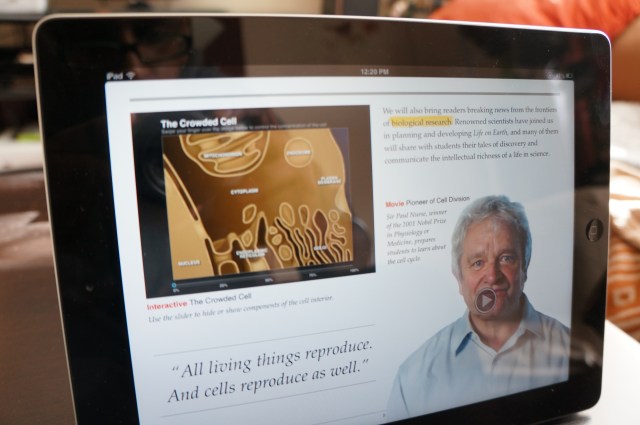
As it did with music and cellphones, Apple today fundamentally redefined what a textbook is with the announcement of iBooks 2 and its accompanying iBooks Author software.
[aditude-amp id="flyingcarpet" targeting='{"env":"staging","page_type":"article","post_id":379723,"post_type":"story","post_chan":"none","tags":null,"ai":false,"category":"none","all_categories":"business,media,mobile,","session":"A"}']The benefits of iBooks 2 and its interactive textbooks were hammered home during Apple’s New York City press event today: they’re interactive, easily updated, portable, the list goes on. But now that Apple’s hype machine has calmed down a bit, the issues with the company’s grand plan to revitalize education are becoming more apparent.
iPads for everyone?
First, there are the obvious problems. For Apple’s digital textbooks to actually take off, more students will need easy access to iPads. I, along with many others, expected Apple to announce some sort of plan to get more iPads in schools. But instead, today’s event ended abruptly as if Apple’s executives left the stage in mid-song.
AI Weekly
The must-read newsletter for AI and Big Data industry written by Khari Johnson, Kyle Wiggers, and Seth Colaner.
Included with VentureBeat Insider and VentureBeat VIP memberships.
In an ideal world, students would actually save money by purchasing an iPad and spending far less on books every semester (Apple’s current digital textbooks retail for $15 and under). For now though, an iPad will be another added expense on top of all the paper books students still need to buy.
For K-12 public schools, it would be the school systems that have to purchase the iPads for students. Again, they may get some major discounts from Apple, but I can’t imagine too many public schools that would be willing to give kids and teenagers an expensive gadget to take home.
In an interview with VentureBeat, Paul Edelman, founder and CEO of the open education marketplace Teachers Pay Teachers, calls the digital textbook’s reliance on the iPad “either a brilliant strategy on Apple’s part, or it will make its overall impact underwhelming.” Teachers have already earned over $4 million on Teachers Pay Teachers selling course guides and other materials to other educators, something that shows many teachers will likely take up Apple’s offer to create textbooks using iBooks Author and sell them on the iBookstore.
Edelman goes on to say, “iBooks Author, though very neat since it is available to everyone, my suffer the same fate since creators of content lock their users into one hardware device. Today teachers create content using many different applications that can then be used on any platform or device. I love Apple, but in education open is better than closed.”
The trouble with iBooks Author
[aditude-amp id="medium1" targeting='{"env":"staging","page_type":"article","post_id":379723,"post_type":"story","post_chan":"none","tags":null,"ai":false,"category":"none","all_categories":"business,media,mobile,","session":"A"}']
The real problem, though, is that Apple doesn’t even ask you to agree to the EULA, it’s assumed that you do if you use the software, as Dan Wineman points out. He writes:
So, to paraphrase: By using this software, you agree that anything you make with it is in part ours. But if it can say that and have legal force, can’t it say anything? Isn’t this the equivalent of a car dealer trying to bind you to additional terms by sticking a contract in the glove compartment? By driving this car, you agree to get all your oil changes from Honda of Cupertino?
Apple has quietly pushed desktop software into uncharted territory with iBooks Author. As Wineman points out, it’s as if Microsoft tried to enforce how you could use a Microsoft Word document. It’s the sort of thing open source software types have been worrying about for years, especially after Apple’s extremely restrictive stance on iOS app development.
A utopia easily becomes a dystopia
While I applaud Apple’s idealism when it comes to technology and education, realistically we’re going to need a lot more than an updated iBooks app and snazzy e-book editor to make a real difference in schools.
Technology-centric solutions also often fail to keep in mind the value of alternatives. There’s certainly something to be said for students engaging with material primarily because of an effective teacher. And when it comes to math problems, students will still need to be able to demonstrate on paper how they reached solutions, even if a calculator or iPad is helping them with the actual number crunching.
[aditude-amp id="medium2" targeting='{"env":"staging","page_type":"article","post_id":379723,"post_type":"story","post_chan":"none","tags":null,"ai":false,"category":"none","all_categories":"business,media,mobile,","session":"A"}']
My biggest worry is that Apple’s vision takes off at the expense of other useful strategies for education. Given the cost of iPads, accessories, and maintenance, many schools could see their budgets blown away on Apple’s products, instead of other non-digital materials that could be just as helpful.
Photos by Devindra Hardawar/VentureBeat
VentureBeat's mission is to be a digital town square for technical decision-makers to gain knowledge about transformative enterprise technology and transact. Learn More
